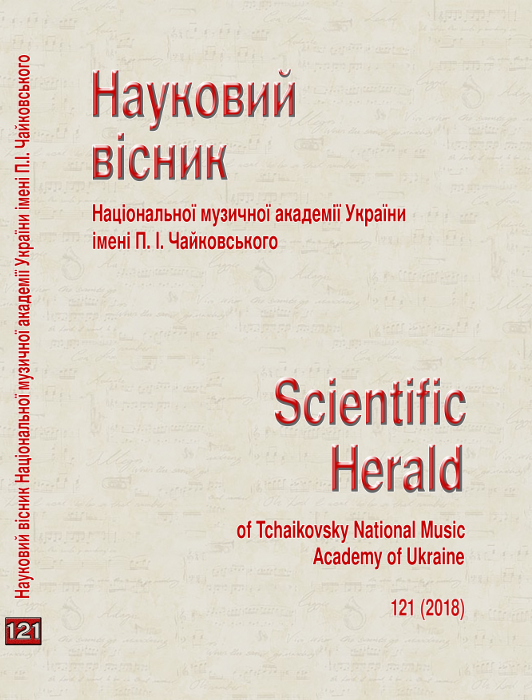Expression Means in Georgian Traditional Music as Signs of Relation with the "Other World"
DOI:
https://doi.org/10.31318/2522-4190.2018.121.133201Keywords:
Georgian traditional music, forms of polyphony, Medium, Other world, Strange voice, glossolalia, KrimanchuliAbstract
Relevance of the study. Musical folklore and church chanting being the most transparent system in the field of music, in the Georgian ethnic environment uses rather diverse symbols of human communication with another world. Studies have not yet reached any significant results in Georgian musicology, in this regard.
Main objective of the study. The paper aims to provide interpretation of the communication between the language of Georgian traditional music and modalities of Christianity, paganism and general aesthetic of the other world.
Methodology. By using the semiotic method, in this article we focus on abstraction-definition, syntactics and pragmatics of individual components of the musical language. With regard to semantic meaning, we mainly refer to hypothetical considerations. We use the comparative method for matching parallel phenomena in music and the emic-etical understanding of the universe, songs and church hymns.
How the study was done. The research has identified the channels in which the components of Georgian traditional music are associated with the concepts of the transcendental world. These are forms of polyphony; three-part singing as an image of the three-dimensional world and the symbol of the Holy Trinity; “strange voice”, descending melody, glossolalia, voice - Initiator-medium; modalities of "order" and "chaos" in monophony and polyphony, priority of string instruments.
Results and conclusions. Basically, musical-expressive means are not marked by high regulation in Georgian ethnographic ritual, but are characterized in polysemy and domination of aesthetic motivation in them today.
Significance of Results. Our hypotheses and factual material will help Georgian ethnomusicologists to master new directions of research, and foreign colleagues to include Georgian material in their work.
Downloads
References
Alekseev, E. (2008), Folklore in the Context of Contemporary Culture: Discourse on the Fates of Folk Songs, Sovetskiy kompozitor, Moskva, 167 p. [in Russian].
Vanslov, V. (1953), Fine Arts and Music: Essays, Hudozhnik RSFSR, Leningrad, 232 p. [in Russian].
Gabisoniya, T. (2014), “Metaphors in music. Parallels of rhetorical figures in Georgian traditional music”, Materialyi Pyatoy nauchnoy konferentsii po semiotike «Mir v metaforah i mir metafor» [Materials of the Fifth Scientific Conference on Semiotics "The World in Metaphors and the World of Metaphors"], Semiotika–XIV, Tbilisi, pp. 7-22 [in Russian].
Gabisoniya, T. (2014), “Dialectics of a second in ethnic music”, Shestoy mezhdunarodnyiy simpozium traditsionnogo mnogogolosya: sbornik dokladov MITsTM [Sixth international symposium of the traditional polyphony: a collection of reports by MITSM], Tbilisi, pp. 168-174 [in Russian].
Gabisoniya, T. (2015), “Semiotic parameters of bourdon in traditional music”, Sedmoy mezhdunarodnyiy simpozium traditsionnogo mnogogolosya: sbornik dokladov MITsTM [Seventh International Symposium of the Traditional Polyphony: a collection of reports by MITCT], Tbilisi, pp. 141-147 [in Russian].
Zhordaniya, I. (2010), “Music and emotion. Humming in the beginning of human history”, ChetvYortyiy mezhdunarodnyiy simpozium traditsionnogo mnogogolosya: sbornik dokladov MITsTM [Fourth international symposium of the traditional polyphony: a collection of reports by MITCT], Tbilisi, pp. 41-49 [in Russian].
Zemtsovskiy, I. (1986), “Theory of perception and ethnomusicology practice”, Sovetskaya muzyika [Soviet music], vol. 3, pp. 62-68 [in Russian].
Kostyuk, A. “On the theory of musical perception”, Muzyikalnoe vospriyatie kak predmet kompleksnogo issledovaniya [Musical perception as a subject of complex research], Muzychna Ukraina, Kiev, pp. 7-17 [in Russian].
Levi, V. (1966), “Questions psychobiology of music”, Sovetskaya muzyika [Soviet music], vol. 8, pp. 37-43 [in Russian].
Medushevskiy, V. (1976), “On the regularities and means of artistic influence of music”, Muzyika, Moscow, 254 p. [in Russian].
Nazaykinskiy, E. (1988), The Sound World of Music, Muzyika, Moscow, 256 p. [in Russian].
Neklyudov, S. (2002), “Folklore: typological and communicative aspects”, Traditsionnaya kultura [Traditional culture], vol. 3 (7), pp. 3-7 [in Russian].
Orlov, G. (1992), The Tree of Music, Frager & So – Sovetskiy kompozitor, Vashington – Sankt-Peterburg, 408 p. [in Russian].
Sohor, A. (1961), Music as an art form, Muzgiz, Moscow, 134 p. [In Russian].
Telcharova, R. (1991) Introduction to the phenomenology of music, In-t filosofii AN SSSR, Moscow, 214 p. [in Russian].
Netl, B. (2015), The science of ethnomusicology. Thirty-three discussions, University of
Illinois Press, 2015. 568 p. [in English].
Downloads
Published
How to Cite
Issue
Section
License
Our journal abides by the CREATIVE COMMONS copyright rights and permissions for open access journals.
Authors, who are published in this journal, agree to the following conditions:
The authors reserve the right to authorship of the work and pass the first publication right of this work to the journal under the terms of a Creative Commons Attribution License, which allows others to freely distribute the published research with the obligatory reference to the authors of the original work and the first publication of the work in this journal.
The authors have the right to conclude separate supplement agreements that relate to non-exclusive work distribution in the form in which it has been published by the journal (for example, to upload the work to the online storage of the journal or publish it as part of a monograph), provided that the reference to the first publication of the work in this journal is included.




